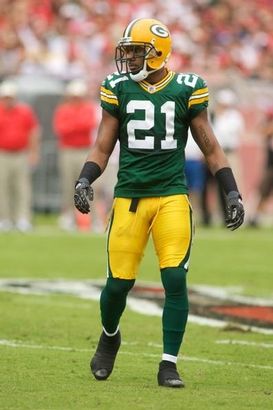Coaching session: blitz techniques
Previously, we talked about the techniques required to play man-coverage on Sundays in the NFL. Feet, eyes, route recognition, wide receiver splits, etc. Today, let’s spend some time talking about blitz techniques. Think of players such as the Steelers’ Troy Polamalu or the Packers’ Charles Woodson—defensive backs that get to the quarterback on a regular basis. What are they doing and what can we learn by studying them on tape?
My tips to becoming a productive blitzer in the NFL...
 ICONThe Packers' Charles Woodson is one of the top blitzing corners in the league.
ICONThe Packers' Charles Woodson is one of the top blitzing corners in the league.
Protections schemes: Six-man, seven-man and eight-man max protection. Is the back going to “scan” to the blitz side? Will the offensive line slide to a pre-snap overload look? Does the guard pop out and take care of secondary pressure? You have to know protections schemes, how to beat them and where the blockers are coming from. I found out the hard way against the Bucs in ’04. Edge pressure vs. “RB scan” protection. Charlie Garner came across the formation and caught me under the chin. Best hit I took in seven years in the NFL.
Hands: Your No.1 weapon. Think of Clay Matthews in Green Bay. Excellent with his hands at the point of attack. You have to create separation with the blocker. Use the swim move, the rip, chop the hands down and press him back. If you can’t disengage from the blocker, you are done. Go into every game with a plan when it comes to your hands—and use every technique possible. Don’t let the blocker figure you out by the end of the first quarter.
Think turnovers: No reason to blitz the QB if you aren’t going to make a play on the football. But, we see it every Sunday. Players who try to hit the QB and forget about raking that hand down to get the ball out. Just like you would tackling a running back, secure the ball carrier and then rip that football out. Watch Woodson this Sunday against Brett Favre. If he gets into the backfield, I guarantee the ball will come out. Coach your players to think turnover when they rush the passer.
Know your opponent: What does the left tackle, the running back or the tight end do in his pass sets that you can take advantage of. Does he keep his hands low? Can you get him on his heels? What have other defensive players done in blitz situations to beat him at the point of attack? You can’t go into Sunday not knowing what to expect from the player you will be working against in pressure schemes. Perfect example—my rookie season in St. Louis. I tried to bull-rush the left tackle of the Falcons. The result: he picked me up and slammed me on the turf—real astro turf. I saw the roof of the Georgia Dome and then felt the back of my helmet hit the turf first. Bad rookie mistake.
Set it up: Using your speed always seems like the first option, but we have to remember just how athletic offensive tackles are in the NFL when it comes to their feet. Instead, set them up with speed early in the game and then use an up-and-under move (just like rushing a punt). Get them to open their hips, plant that foot, dip the shoulder and get back up field to the quarterback. One of a number of moves that we will see.
 Study quarterbacks in the pocket, because they all react differently to pressure.
Study quarterbacks in the pocket, because they all react differently to pressure.
Know the QB: Going to be different when you blitz Michael Vick compared with Ben Roethlisberger or Peyton Manning. Study their actions in the pocket. Understanding how they handle pressure is just as important as your own technique. Do they step up vs. edge pressure? Do they want to break contain, and are they looking to run or throw? Are they tough to bring down? Sounds simple, but if you are going to blitz the QB, it is a good idea to know how he moves in the pocket and reacts to pressure.
Formation recognition: See an empty set? The expect the ball to come out quickly (unless you check to coverage). You know it is going to be five-man protection—and the offense can’t account for the number of blitzers. The solution? Get your hands up. Right hand up vs. a left-handed quarterback and left hand up vs. a right-handed quarterback. And, don’t jump…that’s what the QB wants you to do so he can break contain. Stay on that same path with a hand up in the throwing lane.
Play low: Don’t blitz the “A” gap running straight up and down. Thinking you are going to get that clear, free run to the quarterback every time is fantasyland. Someone is going to step up out of the backfield or an offensive lineman is going to chip you off of your path at the last moment. Keep your pads low so that you can absorb a hit and still get to the QB. I have seen DBs get blasted at the last second by an O-Lineman. Pad level is the key to football.
Want more X's and O's? Click here to check out my Inside the Playbook series.
Follow me on Twitter: MattBowen41